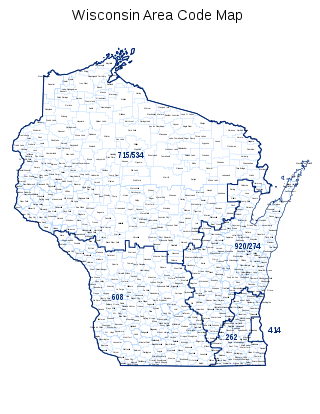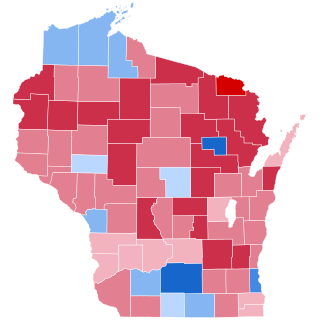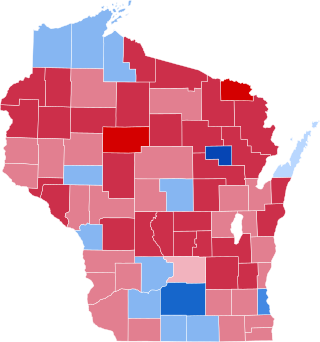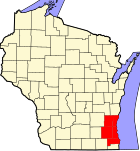
Washington County is a county in the U.S. state of Wisconsin. As of the 2020 census, the population was 136,761. Its county seat is West Bend. The county was created from Wisconsin Territory in 1836 and organized in 1845. It was named after President George Washington.

Racine County is a county in southeastern Wisconsin. As of the 2020 census, its population was 197,727, making it Wisconsin's fifth-most populous county. Its county seat is Racine. The county was founded in 1836, then a part of the Wisconsin Territory. Racine County comprises the Racine metropolitan statistical area. This area is part of the Milwaukee-Racine-Waukesha combined statistical area. According to the U.S. Census Bureau, the county has an area of 792 square miles (2,050 km2), of which 333 square miles (860 km2) is land and 460 square miles (1,200 km2) (58%) is water. The county's unemployment rate was 5.6% in June 2021.

Milwaukee County is located in the U.S. state of Wisconsin. At the 2020 census, the population was 939,489, down from 947,735 in 2010. It is both the most populous and most densely populated county in Wisconsin, and the 45th most populous county nationwide; Milwaukee, its eponymous county seat, is also the most populous city in the state. The county was created in 1834 as part of Michigan Territory and organized the following year.

The Milwaukee metropolitan area is a major metropolitan area located in Southeastern Wisconsin, consisting of the city of Milwaukee and some of the surrounding area. There are several definitions of the area, including the Milwaukee–Waukesha–West Allis metropolitan area and the Milwaukee–Racine–Waukesha combined statistical area. It is the largest metropolitan area in Wisconsin, and the 39th largest metropolitan area in the United States.

Area code 262 is a telephone area code in the North American Numbering Plan for the southeastern part of the U.S. state of Wisconsin. The numbering plan area comprises suburbs that are a part of the Milwaukee and Chicago metropolitan areas. The area code was created on September 25, 1999, in an area code split of area code 414.

The 2008 United States presidential election in Wisconsin took place on November 4, 2008, as part of the 2008 United States presidential election in which all 50 states plus the District of Columbia participated. State voters chose 10 electors to represent them in the Electoral College via a popular vote pitting Democratic U.S. Senator from Illinois Barack Obama, and his running mate U.S. Senator from Delaware Joe Biden, against Republican challenger and U.S. Senator from Arizona John McCain and his running mate, Alaska Governor Sarah Palin.

The 2012 United States presidential election in Wisconsin took place on November 6, 2012, as part of the 2012 United States presidential election in which all 50 states plus the District of Columbia participated. Wisconsin voters chose 10 electors to represent them in the Electoral College via a popular vote pitting incumbent Democratic President Barack Obama and his running mate, Vice President Joe Biden, against Republican challenger and former Massachusetts Governor Mitt Romney and his running mate, Congressman Paul Ryan.

The 1988 United States presidential election in Wisconsin took place on November 8, 1988. All 50 states and the District of Columbia, were part of the 1988 United States presidential election. State voters chose 11 electors to the Electoral College, which selected the president and vice president.

The 1984 United States presidential election in Wisconsin took place on November 6, 1984. All 50 states and the District of Columbia, were part of the 1984 United States presidential election. State voters chose 11 electors to the Electoral College, which selected the president and vice president of the United States.

Brad Schimel is an American lawyer, judge, and Republican politician. He was the 44th attorney general of Wisconsin, serving from 2015 to 2019. He was defeated seeking re-election in 2018, and was subsequently appointed a Wisconsin circuit court judge in Waukesha County, Wisconsin, by Governor Scott Walker. Schimel is seeking election to the Wisconsin Supreme Court in the 2025 Spring election. He also previously served as district attorney of Waukesha County.
Janel Brandtjen is an American politician and businesswoman from Waukesha County, Wisconsin. She is a member of the Wisconsin State Assembly, representing the 22nd Assembly district since January 2015.

The 2016 United States presidential election in Wisconsin was held on November 8, 2016, as part of the 2016 United States presidential election. Wisconsin voters chose 10 electors to represent them in the Electoral College via a popular vote pitting Republican Party nominee Donald Trump against Democratic Party nominee Hillary Clinton.

The 2018 United States Senate election in Wisconsin took place on November 6, 2018, concurrently with a gubernatorial election, U.S. House elections and various other state and local electoins. Incumbent Democratic senator Tammy Baldwin won re-election to a second term, defeating Republican nominee Leah Vukmir by more than 10 percentage points. This was one of 11 Democratic-held U.S. Senate seats up for election in a state Donald Trump won in the 2016 presidential election. The primary elections were held on August 14, with a filing deadline on June 1. Baldwin was unopposed for the Democratic nomination, while Vukmir defeated Charles Barman, Griffin Jones, George Lucia and Kevin Nicholson in the Republican primary.

The 1968 United States presidential election in Wisconsin was held on November 5, 1968, as part of the 1968 United States presidential election. State voters chose 12 electors to the Electoral College, who voted for president and vice president.

The 2018 United States House of Representatives elections in Wisconsin were held on November 6, 2018, to elect the eight U.S. representatives from the state of Wisconsin, one from each of the state's eight congressional districts. The elections coincided with other elections to the House of Representatives, elections to the United States Senate, and various state and local elections. The Wisconsin Partisan Primary was held on August 14, 2018, with the governor, U.S. Senator, U.S. Representative, odd-numbered Wisconsin State Senate seats, and all Wisconsin Assembly seats on the ballot. Wisconsin was notable in 2018 for being the only state in which the party receiving the majority of votes held a minority of congressional seats.

The 2020 United States House of Representatives elections in Wisconsin was held on November 3, 2020, to elect the eight U.S. representatives from the state of Wisconsin, one from each of the state's eight congressional districts. The elections coincided with the 2020 U.S. presidential election, as well as other elections to the House of Representatives, elections to the United States Senate and various state and local elections. Primaries were held on August 11, 2020.
Chuck Wichgers is an American businessman and Republican politician from Waukesha County, Wisconsin. He is a member of the Wisconsin State Assembly, representing the 82nd Assembly district since January 2023. Prior to the 2022 redistricting, he represented the 83rd Assembly district for three terms (2017–2022).

The 2020 United States presidential election in Wisconsin was held on Tuesday, November 3, 2020, as part of the 2020 United States presidential election in which all 50 states plus the District of Columbia participated. Wisconsin voters chose electors to represent them in the Electoral College via a popular vote, pitting the Republican Party's nominee, incumbent President Donald Trump, and running mate Vice President Mike Pence against Democratic Party nominee, former Vice President Joe Biden, and his running mate California Senator Kamala Harris. Wisconsin has 10 electoral votes in the Electoral College.

The 2022 Wisconsin gubernatorial election was held on November 8, 2022, to elect the governor of Wisconsin. Incumbent Democratic governor Tony Evers won re-election to a second term by a margin of 3.4%, defeating Republican nominee Tim Michels.

The 2020 Wisconsin Fall General Election was held in the U.S. state of Wisconsin on November 3, 2020. All of Wisconsin's eight seats in the United States House of Representatives were up for election, as well as sixteen seats in the Wisconsin State Senate and all 99 seats in the Wisconsin State Assembly. Voters also chose ten electors to represent them in the Electoral College, which then participated in selecting the president of the United States. The 2020 Fall Partisan Primary was held on August 11, 2020.



















